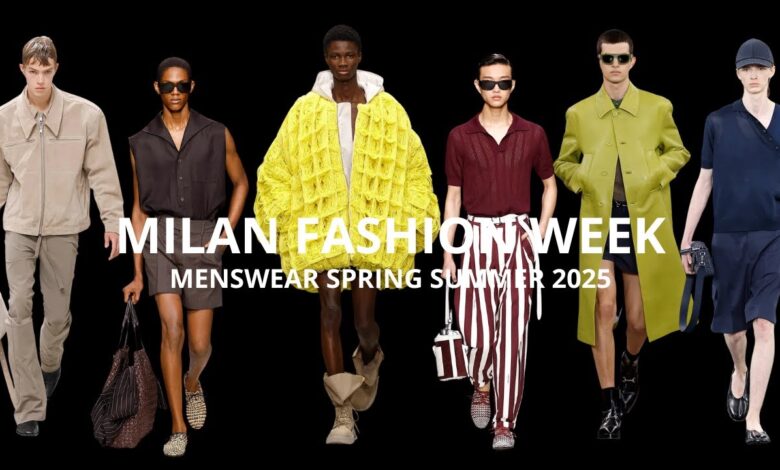Milan Fashion Week 2025: A Glimpse into the Future of Fashion

Milan Fashion Week 2025 was a spectacle that captivated the fashion world, showcasing the latest trends, innovative designs, and the creative prowess of renowned designers. This year, the event not only celebrated the artistry of fashion but also highlighted the evolving dynamics of the industry. From avant-garde collections to sustainable practices, Milan Fashion Week 2025 set the stage for the future of fashion.
The Evolution of Milan Fashion Week
Milan Fashion Week has long been a cornerstone of the global fashion calendar, known for its blend of tradition and innovation. In 2025, the event took a significant step forward, embracing digital transformation while retaining its rich heritage. The integration of virtual platforms allowed a global audience to experience the runway shows in real-time, breaking geographical barriers and democratizing access to high fashion.
The physical shows were equally impressive, with designers transforming iconic venues into immersive experiences. The use of augmented reality and interactive installations added a futuristic touch, engaging attendees in new and exciting ways. This fusion of technology and fashion underscored Milan’s position as a leader in the industry, setting trends that others are sure to follow.
Key Trends from Milan Fashion Week 2025
1. Sustainable Fashion Takes Center Stage
Sustainability was a dominant theme at Milan Fashion Week 2025. Designers showcased collections made from eco-friendly materials, emphasizing the importance of ethical production processes. Brands like Gucci and Prada introduced lines that focused on reducing environmental impact without compromising on style.
The use of recycled fabrics, organic dyes, and zero-waste patterns became more prevalent, reflecting a collective industry effort towards sustainability. This shift is not just a trend but a movement towards a more responsible and conscious fashion industry.
2. Digital Innovation in Fashion
The digital revolution continued to influence Milan Fashion Week in 2025. Designers embraced virtual reality, 3D modeling, and digital fashion shows to present their collections. This approach allowed for greater creativity and experimentation, as designers were no longer limited by the constraints of physical spaces.
Virtual fashion shows attracted a global audience, with viewers from different time zones able to experience the collections simultaneously. The integration of digital elements also opened up new avenues for collaboration between fashion and technology, paving the way for future innovations.
3. Gender Fluidity and Inclusivity
Milan Fashion Week 2025 witnessed a significant shift towards gender-fluid fashion. Designers presented collections that blurred traditional gender lines, offering clothing that could be worn by anyone, regardless of gender. This inclusivity was reflected in the diverse casting of models, showcasing a range of ethnicities, body types, and gender identities.
Brands like Versace and Fendi led the way in promoting inclusivity, with collections that celebrated diversity and self-expression. This movement towards gender-neutral fashion is a testament to the industry’s commitment to embracing change and fostering an environment where everyone feels represented.
Spotlight on Designers and Collections
Fendi’s Centenary Celebration
Fendi marked its 100th anniversary with a spectacular show that paid homage to its rich heritage while looking towards the future. The collection featured a blend of classic designs and innovative silhouettes, showcasing the brand’s evolution over the decades.
Creative Director Silvia Venturini Fendi incorporated archival pieces into the collection, reimagining them with modern twists. The use of luxurious materials and intricate detailing highlighted the brand’s commitment to craftsmanship and quality.
Gucci’s Digital Debut
Gucci embraced the digital age with its first fully virtual fashion show. The collection was presented through an immersive online experience, allowing viewers to explore the designs in 360 degrees. This innovative approach garnered widespread acclaim and set a new standard for digital fashion presentations.
The collection itself was a fusion of traditional craftsmanship and futuristic design, with bold colors and avant-garde silhouettes. Gucci’s digital debut demonstrated the brand’s ability to adapt to changing times while maintaining its distinctive aesthetic.
Prada’s Sustainable Showcase
Prada took a bold step towards sustainability with its 2025 collection, focusing on eco-friendly materials and ethical production methods. The designs featured minimalist silhouettes and neutral tones, reflecting a commitment to timeless style and environmental responsibility.
The use of recycled fabrics and sustainable practices underscored Prada’s dedication to reducing its ecological footprint. The collection was a testament to the brand’s ability to innovate while staying true to its core values.
The Future of Fashion: Milan’s Role
Milan Fashion Week 2025 reaffirmed the city’s status as a global fashion capital. The event showcased the industry’s adaptability and resilience, highlighting the importance of innovation, sustainability, and inclusivity.
Looking ahead, Milan is poised to continue leading the way in fashion. The integration of technology, commitment to ethical practices, and celebration of diversity will shape the future of the industry. Milan Fashion Week will undoubtedly remain at the forefront of these developments, influencing trends and setting standards for years to come.